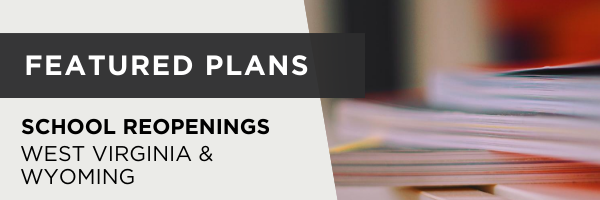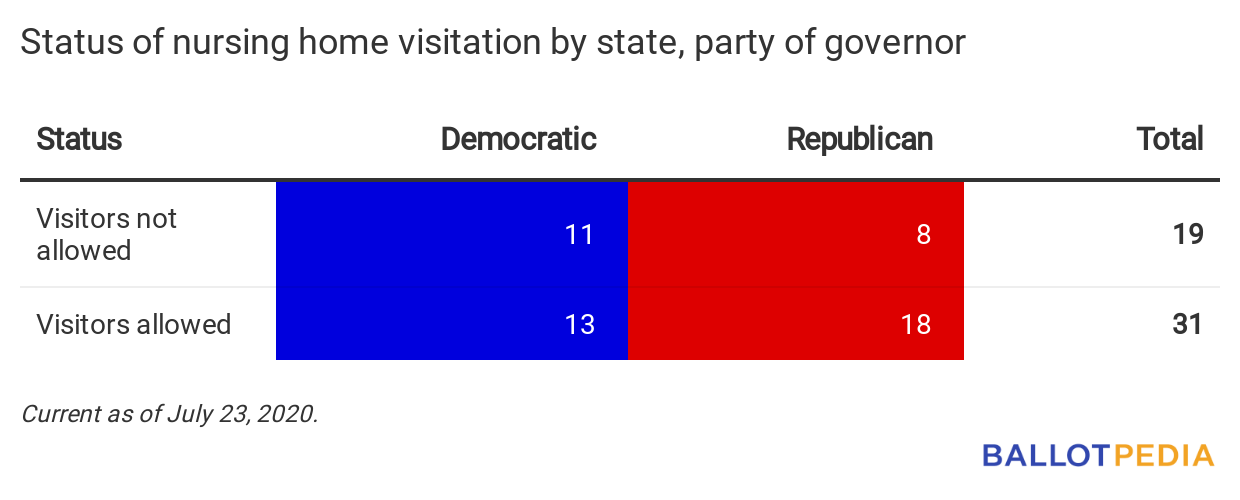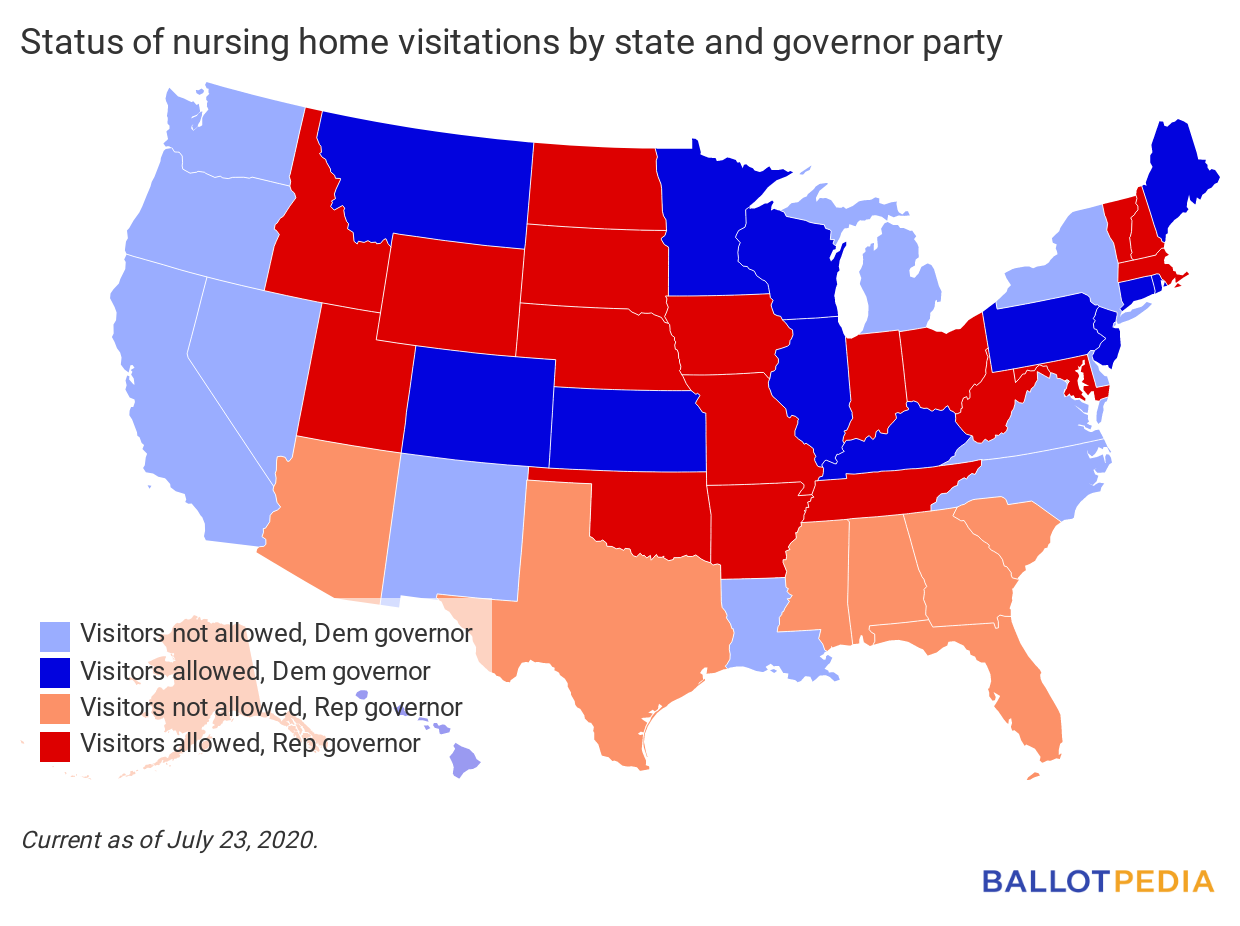
This is an in-depth summary of two state plans to reopen public K-12 schools for the 2020-2021 school year.
West Virginia’s Re-entry Toolkit
The West Virginia Department of Education released school reopening guidance on July 8.
West Virginia does not have an official date for public schools to reopen, but Gov. Jim Justice (R) said the state is aiming to re-start on Sept. 8. According to EdWeek, public schools in West Virginia traditionally start the academic year between early and mid-August, with the exact start date varying by district.
On March 13, Gov. Justice closed public schools indefinitely. On March 21, the state announced schools would remain closed through April 17. On April 1, the closure was extended through April 30. Justice ended the public school year on April 21.
Context
West Virginia is a Republican trifecta. The governor is a Republican, and Republicans hold majorities in both chambers of the state legislature. The state became a Republican trifecta in 2017.
The following tables show public education statistics in West Virginia, including a rank comparing it to the other 49 states. Rank one is the highest number of each figure, rank 50 is the lowest. All data comes from the Common Core of Data provided by the National Center for Education Statistics.
| West Virginia public school metrics |
| Category |
Figure |
Rank |
| Per pupil spending (’16-’17) |
$12,736 |
28 |
| Number of students (’18-’19) |
267,976 |
39 |
| Number of teachers (’16-17) |
19,356 |
38 |
| Number of public schools (’18-’19) |
725 |
40 |
| Student:teacher ratio (’18-’19) |
14.2 |
33 |
| Percent qualifying for free/reduced lunch (’16-’17) |
44.6% |
34 |
| West Virginia public school revenue |
| Category |
Figure |
Rank |
| Total revenue |
$3,525,371,000 |
38 |
| Percent from federal sources |
10.3% |
17 |
| Percent from state sources |
57.5% |
13 |
| Percent from local sources |
32.2% |
39 |
Details
District reopening plans
County school boards are free to develop their own schedules and re-entry plans as long as they comply with state requirements. State guidance does not indicate that such plans need to be formal, publicly posted, or submitted to the state, though schools and counties are advised to “Clearly communicate re-entry plans with students, families and school staff. Identify and address concerns related to re-entry.”
In-person, hybrid, and online learning
The reopening plan allows county boards of education to choose between fully in-person, blended, and online schedules depending on the effects of the coronavirus and the needs of students in their districts. Counties are required to offer a fully online curriculum option for families who want such an option. Parents who want to enroll their children in an online program must contact their county’s board of education. The plan also notes, “Districts must be prepared to implement full remote learning should it be required by the Governor.”
Mask requirements
West Virginia’s reopening plan contained the following mask requirements for staff and students:
| “ |
- Face coverings are required of all staff when they cannot provide instruction in a socially distanced manner.
- Unless medically waived, students grades 3 and above are required to wear face coverings when outside of their core classroom group or in congregant areas.
- Any student who cannot wear a mask or face shield due to a medical condition, including those with respiratory issues that impede breathing, a mental health condition, or disability, and students who would be unable to remove a mask without assistance are not required to wear face coverings. Individuals who are communicating or seeking to communicate with someone who is hearing impaired or who has another disability, where the ability to see the mouth is essential to communication, are not required to wear a mask; however, individuals should consider using another type of face covering such as a plastic face shield.
- Students in middle and high school are required to wear face coverings in congregant areas and in classrooms if they are not in their core groups and/or social distancing cannot be maintained.
|
” |
In-person health recommendations and requirements
Schools and county boards that choose to reopen for in-person and blended instruction are required to implement the following safety precautions:
| “ |
- Provide social distancing floor/seating markings in waiting and reception areas.
- Mark or designate six feet of spacing to remind students and staff to always stay six feet apart in lines and at other times when they may congregate.
- Provide marks on the floors of restrooms and locker rooms to indicate proper social distancing.
- Limit nonessential visitors and activities involving external groups or organizations.
- Monitor arrival and dismissal of students to discourage congregating and ensure students report directly to classrooms or designated areas.
- Develop policies and procedures to address appropriate social distancing to accommodate essential parent/ guardian meetings, such as IEPs, disciplinary action, etc.
|
” |
The plan also includes the following recommendations to limit the spread of the coronavirus:
| “ |
- Minimize opportunities for sustained exposure (15 minutes or more) by ensuring sufficient social distancing with at least six feet between people whenever possible (e.g., adequate space exists in hallways, classrooms are large enough or class sizes are small enough, students and staff utilize large outdoor spaces).
- Provide frequent reminders for students and staff to stay at least six feet apart from one another.
- When feasible, arrange desks or seating so that students are separated from one another by six feet. If it is not possible to arrange seating six feet apart, consider having all students sit facing the same direction (i.e., all sitting on the same side of a table).
- Designate hallways as one-way, posting directional reminders on the walls and/or floor.
- Designate entrance and exit doors for classrooms and restrooms to reduce people meeting face-to-face.
- Keep students and teachers in small core groups as much as possible during the day, and from day-to-day. Limit mixing between core groups (e.g., during recess, lunch, arrival and dismissal).
- Suspend activities that involve bringing together large groups of people or activities that do not allow for social distancing, including assemblies, large groups using playground equipment simultaneously, etc.
- Whenever possible, conduct events such as field trips, parents/family meetings, assemblies and performances virtually.
|
” |
To view cleaning and hygiene guidelines for schools, students, and staff, click here (page 12).
Transportation and busing requirements and restrictions
West Virginia’s reopening plan contains the following requirements for schools and counties coordinating transportation for in-person and blended learning:
| “ |
- Require bus drivers to wear face coverings/shields any time children are entering or exiting the bus.
- Clean and disinfect frequently touched surfaces in the vehicle (e.g., surfaces in the driver’s cockpit, hard seats, arm rests, door handles, seat belt buckles, light and air controls, doors and windows, and grab handles) before all routes.
- Fully clean and disinfect transportation vehicles regularly and/or as needed. Children must not be present when a vehicle is being cleaned.
- Develop procedures for the proper disposal and/or laundering of cleaning supplies after use.
- Keep doors and windows open when cleaning the vehicle and between trips to let the vehicles thoroughly air out.
- Clean, sanitize and disinfect equipment including items such as car seats, wheelchairs, walkers and adaptive equipment being transported to schools.
- Ensure safe and correct use and storage of cleaning and disinfectant products, including storing products securely away from children and providing adequate ventilation when staff use such products.
- Provide hand sanitizer (with at least 60% alcohol) to support healthy hygiene behaviors on all school transportation vehicles for safe use by staff and older children.
- Hand sanitizer should only remain in school vehicles while they are in use as heat and direct sunlight can degrade its effectiveness.
- Systematically and frequently check and refill hand sanitizers.
- Require teachers and students to view “Safe Bus Loading & Unloading Procedures” video to address best practices related to transportation safety.
- Develop seating arrangements and protocols to limit the number of students to no more than two per seat. Face coverings are recommended. The school county may provide face coverings for students if they do not have one.
|
” |
West Virginia recommends schools take the following steps to ensure safe transportation for students:
| “ |
- Utilize seating arrangements that require siblings and/or any students who cohabitate to sit together. Students living in the same household may be permitted to sit three to a seat, when possible. Keep bus stop groups of students together in the same section of the bus. WVBE Policy 2525 stipulations for pre-k students still apply.
- Design appropriate bus loading and unloading procedures and/or seating charts to minimize contact between students.
- If appropriate and safe, consider keeping windows open while the vehicle is in motion to help reduce spread of the virus by increasing air circulation.
- Evaluate each bus route to safely maximize occupancy and capacity to ensure bus loads are equalized.
- Create a contingency plan for the transportation of students who may experience any COVID-19 symptoms during the course of the school day.
- When feasible, utilize procedures for loading and unloading buses to limit the number of students entering/ exiting the building at one time.
- Mask policy on buses
- Capacity limits on buses
- Changes to rules for student drop-off
|
” |
Wyoming’s Smart Start
The Wyoming Department of Education released public school reopening guidance on July 1. School districts will use the guidance to craft individual reopening plans.
On March 20, Gov. Mark Gordon (R) ordered public schools to close through April 3. Gordon extended the closure three times: March 27 (through April 17), April 3 (through April 30), and April 29 (through May 15). Schools in the state were allowed to reopen beginning May 15 pending approval from local authorities.
Wyoming does not have a statewide date for public schools to reopen. According to EdWeek, public schools in Wyoming traditionally start the academic year in August, with the exact date varying by district.
Context
| Wyoming public school metrics |
| Category |
Figure |
Rank |
| Per pupil spending (’16-’17) |
$20,317 |
5 |
| Number of students (’18-’19) |
94,313 |
49 |
| Number of teachers (’16-17) |
7,506 |
50 |
| Number of public schools (’18-’19) |
363 |
46 |
| Student:teacher ratio (’18-’19) |
12.9 |
43 |
| Percent qualifying for free/reduced lunch (’16-’17) |
38.60% |
41 |
| Wyoming public school revenue |
| Category |
Figure |
Rank |
| Total revenue |
$1,961,721,000 |
46 |
| Percent from federal sources |
6.2% |
42 |
| Percent from state sources |
56.9% |
15 |
| Percent from local sources |
36.9% |
31 |
Details
District reopening plans
The state’s 48 public school districts are responsible for developing reopening plans in accordance with the guidance and for submitting those plans for state approval. Each plan must account for three scenarios: traditional learning, hybrid learning (a mix of in-person and distance learning), and distance-only learning. The plans are due by Aug. 3.
In-person, hybrid, and online learning
Districts are to develop plans that include scenarios for in-person, hybrid, and online-only learning. The state labels these different scenarios as tiers, defined as follows:
| “ |
- Tier I – Open
- In-person classes and activities, as appropriate. Minimal adapted learning on a limited, as-needed basis. Most students in school at the same time under the provisions of current health orders. Social distancing and face coverings to the greatest extent possible. Buildings open to all students.
- Tier II – Hybrid
- Combination of in-person and adapted learning is required due to local or state health directives. Social distancing and face coverings to the greatest extent possible for those attending in person. Buildings open to some students.
- Tier III – Closed
- School buildings closed to students due to local or state health directives or orders. School districts will follow provisions in the approved adapted learning plan. Buildings not open to students.
|
” |
Mask requirements
The guidance says that in both Tier I and Tier II, face coverings should be used “to the greatest extent possible” for those attending school in person.
In-person health recommendations and requirements
The guidance recommends that during Tier I and Tier II, physical education classes meet outside if possible and that schools adhere to local health department recommendations regarding recess and other outdoor activities.
The guidance recommends that schools serve students food in classrooms or other designated areas rather than cafeterias. Each district is required to “operate district nutrition services in a way that maximizes social distancing, use of face coverings, and appropriate hygiene measures.”
The guidance recommends that desks be placed six feet apart when possible. It also recommends that districts develop protocols to ensure social distancing in hallways, during arrival and dismissal, and during moments of student movement during the school day.
Transportation and busing requirements and restrictions
The guidance requires each district to transport students “in a way that maximizes social distancing, use of face coverings, and appropriate hygiene measures.” It recommends that students wear face coverings “to the greatest extent possible” when social distancing is not possible.
The guidance recommends that members of the same household are seated together on the bus and that each bus have an area for students that are visibly sick.
Additional activity
In this section, we feature examples of other federal, state, and local government activity, as well as influencers relevant to recovering from the pandemic.
- AMC Theaters announced it was delaying its reopening date to “mid to late August.” Previously, the theater chain had announced reopening dates of both July 15 and July 30.
- Baltimore Mayor Bernard Young ordered restaurants in the city to suspend indoor dining services for two weeks effective July 24 at 5 p.m. The city will also require everyone over the age of 2 to wear a face mask in public.
|




